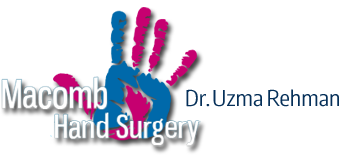Restoring Hand Function with Nerve Transfer Surgery
Hand function is vital for our daily lives, enabling us to perform intricate tasks – like use a smart phone or change a channel – with precision and dexterity. But few of us stop to think about the complex network of nerves that enable the fingers and hands to perform these everyday tasks.
However, when nerves in the hand are injured or damaged, it can lead not only to loss of sensation, but also interfere with one’s motor control and ability to perform even the simplest of tasks.
The good news is that revolutionary nerve transfers, in combination with the remarkable capacity of our brains to rewire and adapt (neuroplasticity), offer a groundbreaking approach to restoring hand function. In this article, top Detroit area hand surgeon Dr. Uzma Rehman explains the remarkable technique of nerve transfers – including its applications, advantages, and the recovery process involved.
What is a Nerve Transfer Surgery?
Nerve transfers in the hand involve surgically rerouting healthy nerves from one part of the body to the injured area in the hand. This procedure utilizes the concept of “spare parts” within our nervous system, where certain nerves serve similar functions in different areas.
By connecting these “spare” nerves to the damaged ones, the brain can regain the ability to send signals to the hand and restore motor control.
Development and Use of Nerve Transfers
Nerve transfers have been developed and refined over the past few decades as a surgical technique for hand reconstruction. Initially pioneered in the 1970s, they have since undergone significant advancements in surgical approaches in the last several years.
Nerve transfers are commonly used in cases where a major nerve in the hand, such as the median or ulnar nerve, is damaged or severed due to trauma, tumors, or other conditions. They are particularly effective in situations where direct nerve repair is not possible – or when the extent of nerve damage makes traditional repair less likely to succeed.
Advantages of Nerve Transfer Surgery
Nerve transfers allow for quicker functional recovery compared to other traditional treatment options. By rerouting functioning nerves, the brain can regain control of hand movements sooner, enhancing rehabilitation outcomes.
Nerve transfers also offer the potential for more refined and precise motor control. The transferred nerves are often smaller and more specialized, enabling more precise movements and fine motor skills. With successful nerve transfers, individuals can regain a broader range of motion in their hand, allowing for improved grasping and manipulation of objects.
And, amazingly, in some cases, nerve transfers can restore not only motor function but also reinstate sensation in the hand. This can greatly enhance the overall functionality and quality of life for individuals who have suffered nerve damage in the hand due to injury or disease.
Recovery from Nerve Transfer Surgery
The recovery process after nerve transfers typically involves a combination of surgical rehabilitation techniques that are customized by your hand specialist for each individual patient. Following surgery, patients undergo a comprehensive rehabilitation program that includes physical therapy, occupational therapy, and specialized exercises.
Thanks to the brain’s remarkable ability to adapt, known as neuroplasticity, the brain can actually reorganize itself and form new neural connections. So, after nerve transfer, this allows the brain to adapt to the newly rerouted nerves and regain control over hand movements. Through repetitive exercises and dedicated rehabilitation, the brain rewires itself, strengthening the connections and reestablishing communication with the hand.
The recovery timeline varies depending on individual factors and the extent of the injury. Some patients begin to see improvements within a few weeks or months, while others may require longer periods of rehabilitation. Consistency, patience, and commitment to therapy are essential for maximizing recovery outcomes after nerve transfer of the hand.
Hand Nerve Transfer Surgery | Detroit Area
In the hands of a skilled, board-certified hand surgeon like Dr. Rehman, nerve transfer, in combination with the brain’s remarkable ability to adapt through neuroplasticity, can provide patients with an innovative and highly effective approach to restoring hand function.
At Macomb Hand Surgery in the greater Detroit area we also offer comprehensive rehabilitation including specialized physical and occupational hand therapy – so our patients can embark on a successful journey of recovery, regaining independence and restoring their ability to perform daily tasks with their hands.

